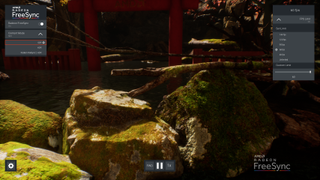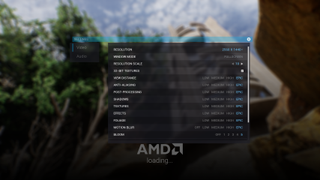AMD made a big FreeSync 2 tech demo
AMD reminds us its new 5.4GB 'Oasis' demo is "NOT meant to be a benchmark."

AMD released a tech demo this morning showcasing the capabilities of FreeSync 2, the company's adaptive sync technology designed to eliminate screen tearing on HDR monitors. It's called Oasis, and at first blush, you'd probably guess it's a synthetic benchmark tool for comparing and testing various displays.
I mean, it's a virtual tour of a lush, fantastical landscape rendered in real-time, complete with a comprehensive list of toggleable video and audio settings, and a frame rate counter in the upper right-hand corner. You can speed up the sequence to move at up to four times its original pace, and you can even reverse it if you want all the nausea of the Wild Mouse without any of the joy. Every aspect of its interface reminds us of a benchmarking tool, like UL's 3DMark or Unigine Superposition. And yet, in the reviewer's guide for Oasis, AMD explicitly states the opposite:
"The purpose of this application is to demonstrate the features and advantages of AMD Radeon FreeSync and AMD Radeon FreeSync 2 HDR over conventional display methods," the guide says. "This application is NOT meant to be a benchmark, nor is it meant to be a tool with which to compare products."

As cool and useful as a FreeSync 2 benchmarking application would have been for testing out and reviewing monitors, this is just a casual 5.4GB demo to demonstrate the advantages of FreeSync and HDR compared to a standard display. So instead of booting up an HDR-supported game and playing it the old fashioned way, the sales department can loop the demo—for a whole 1 minute and 30 seconds—to show off oversaturated moss-covered rocks, petunias, rippling water and AMD logos galore from the comfort of a floating camera.
Because it has configurable options, it can be run with HDR and FreeSync on or off, in case words aren't enough to explain the nuances of display tech to customers. Of course, it does look markedly worse with HDR disabled, as everything appears grayer and washed out, as if someone turned down the saturation in Photoshop or Instagram. And there's noticeable screen tearing when FreeSync is switched off, obviously.
Otherwise, there's a long list of in-depth visual settings that can be tweaked in Oasis. Or it can auto-detect what's best for the demo PC based on the parts it's using. Housing an Intel Core i7-8700K, an AMD Radeon Radeon VII, 32GB of RAM and a WD Black SN750 NVMe SSD, it took my test rig 44 seconds to get past the initial load screen. It's like AMD borrowed Anthem's load times as a feature.
It requires Windows 10 version 1809 (that is, the October 2018 update) or later, and we're told the demo is currently intended as a tool to showcase the benefits of FreeSync and HDR technology for system integrators and sales personnel. Why not just run an HDR capable game instead of a short demo? A public version may come in the future, but your friends or livestream audience will likely be less than enthusiastic about watching this instead of a game.
The biggest gaming news, reviews and hardware deals
Keep up to date with the most important stories and the best deals, as picked by the PC Gamer team.
Most Popular





